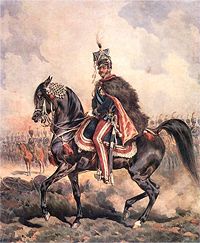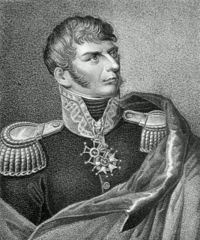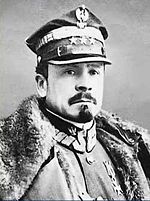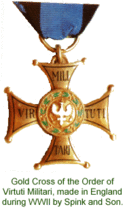Virtuti Militari
2008/9 Schools Wikipedia Selection. Related subjects: Military History and War
| Order of Virtuti Militari | |
|---|---|
 Grand Cross of Virtuti Militari |
|
| Awarded by Republic of Poland | |
| Type | Five classes |
| Eligibility | Military personnel |
| Awarded for | Military virtue |
| Status | Currently awarded |
| Statistics | |
| Established | June 22, 1792 |
| First awarded | 1792 |
| Last awarded | 1989 |
| Precedence | |
| Next (higher) | Order of the White Eagle |
| Next (lower) | Order of Polonia Restituta |
| Related | United States Medal of Honour British Commonwealth Victoria Cross |
The Order Virtuti Militari (Latin for "For Military Virtue") was created in 1792 and is Poland's highest military decoration for valor in the face of the enemy and one of the oldest military decorations in the world still in use. Some of the heroic actions recognized by an award of the Virtuti Militari are equivalent to those meriting the Commonwealth's Victoria Cross, and the U.S. Medal of Honour. It is awarded either for personal heroism or to commanders for leadership.
Awarded in five classes, the order was created in 1792 by Poland's King Stanisław August Poniatowski. Soon after its introduction, however, the Polish-Lithuanian Commonwealth was destroyed (1795) in the partitions of Poland, and the partitioning powers abolished the decoration and prohibited its wearing. Since then, the award has been reintroduced, renamed and banned several times, with its fate closely reflecting the vicissitudes of the Polish people. Throughout the decoration's existence, thousands of soldiers and officers, Polish and foreign, several cities and one ship have been awarded the Virtuti Militari for valor or outstanding leadership in war. There have been no new awards since 1989.
Beginnings
Throughout its history, the Virtuti Militari has shared its country's fate, and has been abolished and reintroduced several times.
The order was originally created on June 22, 1792, by King Stanisław August Poniatowski to commemorate the victorious Battle of Zieleńce. Initially, it comprised two classes: a golden medal for generals and officers, and a silver one for non-commissioned officers and ordinary soldiers. By August 1792, a statute for the decoration had been drafted, which was based on one that was created for the Austrian medal of Empress Maria Theresa. The regulation changed the shape of the decoration from a star to a cross, which has not changed substantially since then. It also introduced five classes to the order.
| 1. Grand Cross with Star | |
| 2. Commander's Cross | |
| 3. Knight's Cross | |
| 4. Golden Medal | |
| 5. Silver Medal |
|
Medal chapter (1792–1794)
|
The first members of the decoration's chapter were also its first recipients. For the Polish-Russian War in Defence of the Constitution of 1792, a total of 63 officers and 290 NCOs and privates were awarded the Virtuti Militari. The statute was never fully implemented, however, since soon after its introduction the King acceded to the Targowica Confederation, which on August 29, 1792 abolished the decoration and prohibited its wearing. Anyone who wore the medal could be demoted and expelled from the army by Poland's new authorities.
Although on November 23, 1793 the Grodno Sejm reintroduced the decoration, it was banned again on January 7, 1794, at the insistence of Russia's Catherine the Great. Only a year later, the Polish-Lithuanian Commonwealth itself shared the fate of its decoration when what remained of the Commonwealth was annexed by its neighbors in the partitions of Poland. King Stanisław August Poniatowski abdicated the same year. During his reign, 526 medals had been granted: 440 Silver Medals and Crosses, 85 Golden Medals and Crosses, and 1 Commander's Cross.
Among the most famous recipients of the Virtuti Militari in this period were Prince Józef Antoni Poniatowski (1763–1813) and Tadeusz Kościuszko (1746–1817), both able military commanders during the War in Defense of the Constitution and the Kościuszko Uprising.
Duchy of Warsaw
|
Recipients (1806–1815)
|
In 1806, Lt. Gen. Prince Józef Poniatowski was promoted to commander-in-chief of all forces of the Duchy of Warsaw, the short-lived Polish state allied with Napoleon I of France. As one of the first recipients of the Virtuti Militari, Poniatowski insisted on the reintroduction of the decoration. Finally on December 26, 1806, the King of Saxony and Duke of Warsaw Fryderyk August Wettin accepted the proposal and reintroduced the Virtuti Militari as the highest military award for all Polish soldiers fighting alongside France in the Napoleonic Wars. The official name of the decoration was changed to the Military Medal of the Duchy of Warsaw; however, soldiers remained faithful to the former name. The royal decree also introduced a new class system that has been in use ever since, with the class of the cross depending on the rank of the soldier to whom it is awarded:
- I Class - Grand Cross (with Star) (Krzyż Wielki z Gwiazdą, for commanders in chief)
- II Class - Commander's Cross (Krzyż Komandorski, for division commanders)
- III Class - Knight's Cross (Krzyż Kawalerski, for brigadiers, colonels and majors)
- IV Class - Golden Cross (Krzyż Złoty)
- V Class - Silver Cross (Krzyż Srebrny)
Initially each of the high commanders of the Army had a quota of Virtuti Militari to be awarded to his soldiers. However, the system was soon changed and, since then, the order has been usually awarded centrally for individual acts of bravery after being nominated by the chain of command. According to the decree of October 10, 1812, each of the recipients of a Golden or Silver Cross had the right to a yearly salary until promoted to officer or (if demobilised) for life. In addition, during the Napoleonic Wars, the present tradition of awarding the soldiers with the Virtuti Militari in front of the unit was established. Between 1806 and 1815, there were 2569 crosses awarded to Polish soldiers fighting on all fronts, from Santo Domingo to Russia and from Italy to Spain.
Among the famous recipients of the medal in this period were General Jan Henryk Dąbrowski (1755–1818), the organiser of Polish Legions during the Napoleonic Wars, for whom the Polish national anthem Mazurek Dąbrowskiego is named, and General Józef Chłopicki (1771–1854). Also, on May 20, 1809, Sergeant Joanna Żubr became the first woman to receive the decoration (V class) for her part in the assault on Zamość.
Congress Poland
|
Recipients (1830–1831)
|
In 1815 at the Congress of Vienna, when European powers reorganised Europe following the Napoleonic wars, the Kingdom of Poland - known unofficially as the Congress Poland - was created. This state, with one-tenth the area of the Polish-Lithuania Commonwealth, and a fifth of its population, was now tied to Russia with a personal union. In the Congress Poland, the Virtuti Militari medal was renamed as the Polish Military Medal (Medal Wojskowy Polski). Both the statute of Virtuti Militari and the privileges granted to the recipients were preserved. A special commission was created to award the Virtuti Militari to veterans of the Napoleonic campaigns of 1812, 1813 and 1814. By 1820, an additional 1213 crosses of all classes were awarded. Also, on June 5, 1817, the royal decree ennobled all officers that received the Golden Cross.
At the time, the Kingdom of Poland was one of the few contemporary constitutional monarchies in Europe, with the Tsar of the Russian Empire as Polish King. The country was given one of the most liberal constitutions in 19th-century Europe, although it was very different from the Polish Constitution of May 3rd of the late Commonwealth. The Polish desire for freedom and respect for their privileges was a source of constant friction between them and the Russians. The main problem was that the tsars, who had absolute power in Russia, similarly wanted no restrictions on their rule in Poland. When in 1825 Nicholas I declined to crown himself King of Poland and instead continued to limit Polish liberties, the Polish parliament in 1830 deposed the Tsar as King of Poland in response to his repeated curtailment of its constitutional rights. When the November Uprising broke out, the Tsar reacted by sending in Russian troops.
|
Provisional chapter (1920)
|
After the outbreak of this uprising against Russia, the Polish Sejm decreed on February 19, 1831 that the decoration be restored to its original name, the "Order Virtuti Militari." Between March 3 and October the same year, 3,863 crosses were awarded. Recipients of the Silver Cross included three women:
- head surgeon of the 10th Line Infantry Regiment, Józefa Kluczycka;
- surgeon's assistant in the 10th Line Infantry Regiment, Józefa Daniel Rostowska née Mazurkiewicz; and
- cadet in the 1st " Augustów" Cavalry Regiment, Bronisława Czarnowska.
After the defeat of the uprising, Tsar Nicholas I abolished the decoration and banned its use. On December 31, 1831, it was replaced with the "Polish Sign of Honour" (Polski Znak Honorowy), an exact copy of the original cross but awarded only to Russians for services to the Tsarist authorities.
Republic of Poland
|
Recipients (1920–1939)
|
After Poland regained her independence in 1918 as the Second Republic of Poland, the Polish Sejm reintroduced the Virtuti Militari on August 1, 1919 under a new official name, the Military Award Virtuti Militari (Order Wojskowy Virtuti Militari). A new statute of the decoration was also passed, and the class system introduced during the times of the Duchy of Warsaw was reintroduced. According to the new statute, crosses of each class could be awarded to a different class of soldiers and for various deeds:
- Grand Cross with Star, I Class: "for a commander who has achieved victory in a battle of strategic importance, resulting in total defeat of the enemy, or a successful defense that has decided the fate of a campaign."
- Commander's Cross, II Class: "for a commander who has achieved a notable tactical victory or a valorous and successful defense of a difficult position."
- Knight's Cross - III Class - For officers, NCOs or ordinary soldiers, awarded previously with the Golden Cross, for acts of outstanding bravery, risk of life or outstanding command over his troops
- Golden Cross - IV Class - For officers who commanded their troops with outstanding bravery and valor or for NCOs and ordinary soldiers previously awarded with the Silver Cross, for acts of outstanding bravery and risk of life on the field of battle
- Silver Cross - V Class - For officers, NCOs or ordinary soldiers, for acts of outstanding bravery and risk of life on the field of battle
Each recipient of the Virtuti Militari, regardless of rank or post, received a yearly salary of 300 złotys.
Other privileges included the right of pre-emption when buying a state-owned land property or applying for a state post. Their children had additional points during exams in state schools and universities. In addition, the recipients of the Virtuti Militari had a right to be saluted by other soldiers of equal rank and NCOs and ordinary soldiers could be promoted one rank up upon receiving the award.
The new chapter of the decoration (Kapituła Orderu Virtuti Militari) was composed of 12 of the recipients of the crosses, four from each of the classes from I to IV. The headperson of the chapter was Marshal of Poland Józef Piłsudski, the only living Pole awarded with the Grand Cross with Star. As the commander-in-chief of the Polish Army, he could award medals of classes I to III with the consent of the Chapter and the IV and V class upon receiving an application from the commander of a division or brigade. The Polish national feast of May 3 was chosen as the feast of the Virtuti Militari.
On January 1, 1920, Piłsudski awarded the first crosses to 11 members of a Provisional Chapter. On January 22, 1920, to commemorate the anniversary of the outbreak of the January Uprising, the first soldiers and officers were officially decorated with the Virtuti Militari for their deeds during the World War I and the Polish-Ukrainian War. By 1923, when the award of new medals was halted, the Chapter had awarded the crosses to 6589 recipients. Most of the recipients were veterans of the Polish-Bolshevik War, but among them were also the veterans of all wars in which Polish soldiers fought in the 20th century, as well as some January Uprising veterans. Among the recipients of the Silver Cross were two cities - Lwów and Verdun, as well as the banners of 14 infantry regiments, 6 cavalry regiments, an engineer battalion, a Women's Auxiliary Service unit and 12 units of artillery.
On November 24, 1922, a new Chapter was chosen for times of peace. The following year, the last medal for World War I and the Polish-Bolshevik War was granted and further decorations were halted. On March 25, 1933, the Sejm passed a new Virtuti Militari Act (Ustawa o Orderze Virtuti Militari) which modified the shape of all the crosses and extended the privileges granted to VM recipients by the previous act of 1919. All recipients of the decoration had the right to buy railway tickets at 20% of their normal price. In addition, the state paid for their health care and was obliged to provide them with jobs that would enable Virtuti Militari recipients to live a decent life. For war invalids, the government was ordered to provide money, food and clothing for the rest of their lives. Finally, the annual salary of 300 złotys was tax-free and could not be impounded by the courts.
Also, the criteria for granting the crosses became more strict:
- Grand Cross - I Class - for the commander-in-chief who won a war or, alternatively, for commanders of armies or fronts who achieved outstanding victories during various campaigns of the war
- Commander's Cross - II Class - for commander of army or front (under special circumstances also commander of a group, division or brigade) for brave and daring command during an operation, which had important influence on the outcome of the war, or for other officers who contributed to the victory
- Knight's Cross - III Class - For commanders of units up to the size of an army, for their outstanding leadership, initiative or bravery. Alternatively for staff officers for their cooperation with their commanders, that led to the final victory in a battle or war
- Golden Cross - IV Class - For a soldier or officer, who was previously awarded with the Silver Cross and achieved an outstanding success on the battlefield thanks to his personal bravery or outstanding command of a division or a smaller unit
- Silver Cross - V Class - for commanders who committed a daring and valorous command over their troops or for ordinary soldiers who influenced their comrades in arms by their bravery thus adding to the final victory in a battle
The Silver Cross could also be awarded to military units, cities and civilians. All classes of the Virtuti Militari medal were awarded by the commander-in-chief during the war or former commander-in-chief after the end of hostilities. The classes from I to III were awarded after a nomination by the Chapter, while the IV and V classes were nominated by the chain of command (usually by the commander of a division or brigade). Apart from the 12 members of the Chapter, all recipients of the I class had a right to take part in the voting.
World War II
During the Polish Defensive War of 1939, the fast German and Soviet advance prevented the Chapter from awarding the medals, especially as Poland's territory was overrun by enemies five weeks after the Invasion of Poland began. Instead, commanders of divisions and brigades usually awarded the bravery of their soldiers with their own crosses received before the war. This was the case of the 18th Pomeranian Uhlans Regiment, awarded with the Virtuti Militari of General Stanisław Grzmot-Skotnicki after the battle of Krojanty, where elements of 18th Uhlans Regiment successfully delayed the advance of the German infantry on September 1, the first day of the Second World War.
| Rank | Name |
|---|---|
| II Class - 3 awarded | |
| Lt General | Władysław Anders |
| Lt General | Tadeusz Bór-Komorowski |
| Brigadier General | Michał Karaszewicz-Tokarzewski |
| III Class - 6 awarded | |
| Lt. General | Władysław Anders |
| Lt General | Stanisław Maczek |
| Brigadier General | Bronisław Duch |
| Lt General | Tadeusz Kutrzeba |
| Brigadier General | Franciszek Kleeberg |
| Brigadier General | Antoni Chruściel |
| IV Class - 201 awarded | |
| V Class - 5363 awarded | |
| Brigadier General | Wilhelm Orlik-Rueckemann |
| City of Warsaw, on November 9, 1940, for the heroic defence in 1939 | |
Following the fall of Poland in 1939, a large part of the Polish Army was evacuated to France, where it was reconstructed under the command of General Władysław Sikorski. In January 1941, the Polish Government in Exile introduced the Virtuti Militari as the highest military decoration of the Polish Army in exile. The legal basis for the election of a new Chapter was the Act of 1933. During the Second World War, the Virtuti Militari was also often bestowed to senior military officers of allied armies, including British General Bernard Montgomery, United States Supreme Commander of the Allied forces Dwight D. Eisenhower, French General Jean de Lattre de Tassigny and Soviet Marshal Georgy Zhukov.
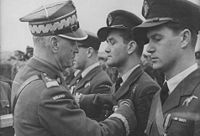
Among the most famous recipients of the medal during this period were Tadeusz Kutrzeba, creator of the Bzura counterattack plan and participant in the defence of Warsaw during the Invasion of Poland; Władysław Anders, commander of the 2nd Polish Corps; Tadeusz Bór-Komorowski, commander of giant Armia Krajowa resistance movement and leader of the Warsaw Uprising; and Stanisław Maczek, one of the best armor commanders of the war, who devised the first anti-blitzkrieg strategy as early as 1940 and was the commander of the 10th Motorized Cavalry Brigade, considered to be the only Polish unit not to lose a single battle in 1939, and from 1942 the commander of the First Polish Armoured Division.
People's Republic of Poland
| Rank | Name (remarks) |
|---|---|
| I Class - 13 awarded | |
| Marshal of the USSR and Poland | Konstanty Rokossowski |
| Marshal of Poland | Michał Rola-Żymierski |
| General | Aleksei Antonov (USSR) |
| Marshal of the USSR | Leonid Brezhnev (revoked on July 10, 1990) |
| Marshal of Yugoslavia | Josip Broz-Tito |
| MJ General | Nikolai Bulganin |
| Marshal of the USSR | Andriey Grechko |
| Marshal of the USSR | Ivan Koniev |
| Marshal of the USSR | Alexander Vasilievski |
| Marshal of the USSR | Georgy Zhukov |
| British Field Marshal | Bernard Montgomery |
| General | Ludvík Svoboda ( Czechoslovakia) |
| General | Karol Świerczewski (posthumously) |
| II Class - 18 awarded | |
| Lt General | Stanisław Popławski |
| Lt General | Juliusz Rómmel |
| Lt General | Karol Świerczewski |
| Major | Henryk Sucharski |
| III Class - 57 awarded | |
| Lt General | Bolesław Kieniewicz |
| Lt General | Władysław Korczyc |
| Lt General | Marian Spychalski |
| IV Class - 227 awarded | |
| V Class - 4852 awarded | |
The Soviet-backed Polish Armies fighting on the Eastern Front were also awarding the Virtuti Militari. On November 11, 1943, General Zygmunt Berling awarded 16 veterans of the Battle of Lenino with Silver Crosses. On December 22, 1944, the Soviet-backed PKWN passed a Virtuti Militari Award Act, in which it accepted the medal as the highest military decoration of both the 1st Polish Army of Red Army and the Armia Ludowa resistance organization.
Although the decree of the PKWN was loosely based on the act of the Polish Sejm of 1933, the exclusive right to award soldiers with the medal was granted to the Home National Council. Since 1947 the right was passed to the President of Poland and, after the replacement of the post with the Council of State, it was passed to that body. Between 1943 and 1989 the communist authorities of the People's Republic of Poland awarded the medal to 5167 people and organisations. Some of the crosses were given to the officers and leaders of the Red Army and other armies allied to the Soviets during and after World War II.
Among the recipients of the Golden Cross was the ORP Błyskawica, probably the only warship in the world to be awarded with the highest-ranking national medal. Among the recipients of the V Class VM were also a number of military units, including two infantry divisions, six infantry regiments, three artillery regiments, four tank regiments, three air force regiments and a number of smaller units.
Republic of Poland (after 1989)
After Poland overthrew the Communist rule in 1989, a number of Virtuti Militari awards made by the communist authorities were brought into question. On July 10, 1990, President Wojciech Jaruzelski revoked the Grand Cross given to Leonid Brezhnev on July 21, 1974. On October 16, 1992, the Polish Sejm passed a new Virtuti Militari Act, which is based on the act of 1933. It restored the Chapter of Virtuti Militari abolished by the communist authorities, while also confirming all decorations bestowed by both the Polish government in exile and the Soviet-backed authorities in Poland.
In 1995, President Aleksander Kwaśniewski revoked the Cross given to Ivan Serov, who was accused of being responsible for the deaths of thousands of Poles. In 2006, President Lech Kaczyński revoked the Cross given to Wincenty Romanowski, who tortured anti-Communist fighters.
Since 1989 there have been no new awards of the Virtuti Militari, and a new act of parliament introduced a rule setting the final deadline for awards at "no later than five years after the cessation of hostilities."

